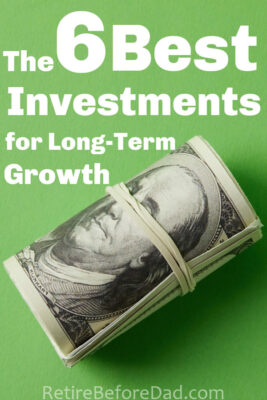The 6 Best Investments is 2024 for Long-Term Growth

As New Year’s resolutions are fresh on your mind, there’s no better time than now to initiate and strengthen wealth-building strategies. To help inspire you, I’ve created a list of the best investments for long-term growth.
This article is about where you can direct your money and time this year so that ten and twenty years from now, you’ll be glad you made the investments.
This article isn’t going to predict the top-performing investments of 2024, and it’s not about making a quick buck.
This article is a good place to start if you want to accelerate your wealth trajectory by creating multiple income streams from targeted investments.
Before we get into the list, here are a few things to remember.
Slow and steady wins the race. That’s the philosophy that I’ve always followed with my investments.
Immediate results are elusive with a patient approach, but long-term desired outcomes are more probable with this mindset.
Investments come in many forms. Your time directed toward a specific goal is one of the best investments you can make.
Think hard about where you spent your free time last year. Did it contribute to your long-term goals?
Finally, always perform due diligence when embarking on new investments. Just because a blogger or someone on YouTube says something is the best doesn’t mean it’s right for you.
Table of Contents
The 6 Best Investments in 2024 for Long-Term Growth
Based on my almost 30 years of investing experience, factoring in my successes and many mistakes and failures, I’ve compiled this list of best long-term investments to initiate in 2024.
These should look familiar. Long-term best investments stay the same year-to-year.
Asset class performance does change year-to-year, but annual winners are anyone’s guess.
Better to stick to what’s proven over the past decades and be patient for success.
In addition to the usual suspects below, consider investing significant time in personal growth to feed your curiosities, educate yourself, and strive to craft your best life.
Those investments pay the best dividends.
1. Stocks
You should buy stocks in 2024. I said that in 2023, and I’ll say it again every year.
Stocks are always near the top of the list because they are easy to own, liquid, and have excellent long-term returns.
I’m not saying if you buy stocks on January 1st, your investments will be worth more on December 31st.
But the money you invest in 2024 will be worth more in 2034 and 2044 — a lot more. Think about investing in 10 to 20-year increments.
If you want to create lasting wealth, investing in the largest and best companies in the world has been a successful strategy over the last century.
Investing in stocks should be regular and consistent.
Utilize your employer-sponsored 401(k) or other tax-advantaged accounts to automatically dollar cost average in broad-based index funds if you’re just starting.
If your employer plan doesn’t have low-cost funds, managed growth stock mutual funds are OK, too, but keep an eye on fees.
You can also start to build passive income through dividend growth investing. Please do thorough research on any individual stock you buy. Focus on companies with long dividend-paying track records and moderate debt exposure.
If you’re not up for stock research, use ETFs to diversify and save time. ETFs are my preference today because I am prioritizing less time for stock research.
Automating asset purchases has gotten easier in the past few years. Nearly all online brokers are commission-free and allow fractional purchases.
That means you can set up regular investments via your broker to buy one or more investments with a set dollar amount.
I recommend the commission-free online broker M1 Finance for beginner and intermediate investors. The minimum investment to get started is $100, and the automation is built in.
Read more: M1 Finance review
Read more: Getting Started with Investing? Here’s What I’d Do
For those looking for help choosing the right stocks, I recommend two investing newsletters.
The Sure Dividend Pro Plan (review) focuses on dividend growth stocks, and the Motley Fool Stock Advisor (review) newsletter provides stock tips on high-growth stocks.
2. A Low-Cost Side Business
Out of college, I landed in a lucrative career — providing a good return on the money invested in my degree. But it wasn’t fulfilling.
That career lasted 20 years and would have lasted another ten-to-twenty years had I not started a side business.
Starting a side business was one of the most rewarding endeavors of my life. It gave me purpose when my career did not and provided a landing pad when I finally left my job in late 2022.
Now, my work is enjoyable and my primary income source.
The internet has made starting a business cheap and low-risk. You can test hundreds of online business models, see if you like them, and quit for less than $100.
With the maturity of the internet and all the platforms from which you can earn money (think WordPress, YouTube, Etsy, eBay, Upwork, Fiverr, Amazon, etc.), and all the free information telling you how to make money online, the opportunities are endless.
Now that starting many kinds of businesses is cheap, the biggest expense is your time. How serious are you about starting something of your own?
Another challenge is finding the right fit. I wanted to be an entrepreneur for many years but didn’t have a viable idea to pursue until I started reading blogs that were making money.
If the internet is intimidating or unintriguing, consider a local side business. Don’t lease a storefront. Start small and figure it out as you go. I waxed skis and snowboards in my college dorm room for extra money back in the day.
Start with something you are passionate about (sports, art, travel, computers, nerdy hobbies, etc.), and research how people with the same interests earn money. Some people start businesses inspired by hobbies, while others are adamant about separating business and pleasure.
Be creative. Try enthusiastically and fail without shame. Learn and try again.
Spend more time and less money on your ideas.
Read more: How to Start an Online Business
3. Venture Capital Funds
Venture capital (VC) is the quintessential long-term investment. Short-term gains are doubtful. But long-term returns outpace most other asset classes.
Most modern technology companies begin their journey with seed money and use venture capital to expand their reach as quickly as possible.
That leads to fast-growing valuations (millions to billions), but all before the companies become traded on stock exchanges.
Airbnb, for example, was worth more than $100 billion right after its IPO. Somebody made money between zero and $100 billion, and it wasn’t retail investors.
Retail investors have historically missed out on these gains because the asset class has been reserved for institutional investors and the wealthy.
Venture capital funds give us access to the Airbnbs of today before they IPO.
The Fundrise Innovation Fund (review) is the simplest way to invest in venture capital, adding a layer of diversification as it owns several pre-IPO startups under one asset.
Investors can now get investment exposure to the next big IPOs, owning private companies such as Databricks, Canva, and ServiceTitan. Fundrise is just getting started.
The fund has a $10 minimum investment.
Check out my recent post about venture capital investing to learn more about this asset class. VC is the most exciting long-term investment newly available to retail investors.
But only use speculative funds (less than 5% of your investable assets) if you decide to invest.
Please note: This is a testimonial in partnership with Fundrise. We earn a commission from partner links on RetireBeforeDad.com. All opinions are my own.
4. Crowdfunded Real Estate
Even though I’m primarily an index fund and dividend stock and ETF investor, rental properties are my favorite investment asset.
That’s because you get capital appreciation, rental income, and significant tax advantages from real estate. Also, there are several ways to finance real estate deals: all cash, mortgage financing, private financing, home equity loans, etc., giving you a ton of flexibility.
Money is made by finding good deals with positive cash flow.
But not everyone is cut out to be a real estate entrepreneur.
I was a landlord for about eight years and enjoyed the business aspect of it. But there were days when tenant-related headaches caused significant stress. I ultimately sold it with little regret.
If the thought of a multi-thousand dollar down payment or being a landlord is off-putting, multiple real estate crowdfunding platforms now exist to provide access to high-quality real estate for small investment amounts. It’s easier than owning investment properties outright.
My latest experiment is on a platform called Arrived Homes (review), where I’ve invested $2,500 in single-family homes and vacation rentals (not available at Fundrise).
Here are my Arrived Homes returns so far. Watch for a video in the coming weeks.
Fundrise (review) remains my top choice. The platform provides access to single-family, multi-family apartments, and commercial properties (aside from VS) for as little as $10.
I’ve invested on the platform for almost seven years, and the returns have been consistently positive. See my recent YouTube video to look inside my account.
Both Arrived Homes and Fundrise provide a simple Form 1099 at tax time.
Accredited investors looking for more substantial real estate equity and debt deals and higher risk/returns can look at crowdfunding sites such as:
I own part of a multi-use residential/commercial property in my hometown via EquityMultiple. Investing on these two platforms offers a more piecemeal approach and requires more sophistication to analyze deals. The tax filings are also more involved (K-1s).
More serious investors looking to build substantial portfolios of individual properties should use these platforms.
5. Diversified Alternative Investments
Technology has enabled a new breed of investment platforms beyond traditional stocks and bonds.
Peer-to-peer lending and real estate crowdfunding were the first to drive this renaissance. But other asset class platforms with similar models quickly followed.
Some of these platforms may seem experimental, as they are still somewhat new. But crowdfunded investing has become commonplace.
Several of these platforms have become more mature and are worth exploring. Some of the most intriguing assets include:
Private Credit
Private credit is an alternative asset class dealing with privately negotiated loans and debt financing, usually between a corporate borrower and a non-bank lender.
Sometimes, businesses need cash for a purpose other than what a bank would traditionally lend for.
For example, a startup could need long-term debt financing to capitalize on a growth opportunity that a bank would consider too risky.
Private credit is nothing new. Hedge funds and institutional investors lend this way.
What is new is that high-quality private credit opportunities are now available to retail investors through a company called Percent.
Percent is a venture-backed startup, making it simple for accredited investors to invest in private credit. Investors can earn up to 20% on certain deals, though average returns are closer to 12% as of early 2024.
Investments mature in as little as one month or as long as a few years. Importantly, Percent prioritizes due diligence and transparency throughout the process.
The minimum investment is $500, allowing investors to diversify among several deals. Percent charges fees up to 10% of interest. For example, if a deal paid 15% APY and the fee was 10% of interest, your effective APY is 13.5% after fees.
Farmland and Agriculture
The real estate crowdfunding model is now available for farmland and agriculture on the AcreTrader platform. The asset class has existed for centuries, but investing has become more accessible through updated laws and streamlined technology.
Farmland is one of my favorite investments for the next decade.
Read more: AcreTrader review
Diversified Alternatives
One of the most innovative platforms I’ve seen in the alternative investment space is called YieldStreet. The company offers several alternative investment types under one roof.
At YieldStreet, you can invest in real estate, legal opportunities, marine financing, commercial loans, and art. The platform is so popular that investments fill up quickly. That’s because returns fall in the 8%-15% range, and the default rate is extremely low.
The opportunities on this website are unique but all vetted and legit. All require investor accreditation.
Read my YieldStreet review and check out the website to learn more.
Fine Art
I first highlighted Masterworks in 2019, when it was an intriguing idea but far outside of mainstream investments. Popularity has exploded since then.
The platform empowers investors to own shares of fine pieces of artwork. The first artwork was an Andy Warhol portrait of Marilyn Monroe.
Masterworks has now purchased 344 paintings, has over 800,000 users on its platform, and over $850 million of assets under management (AUM).
I didn’t expect that kind of success when I first published my Masterworks review four years ago.
Contemporary art has outperformed the S&P 500 since 1997, making it an attractive asset class. However, it was unaffordable to most investors for hundreds of years.
Masterworks implemented a process by acquiring paintings, creating a Delaware-based “special-purpose vehicle”, and securitizing it via Securities and Exchange Commission (SEC) filings.
There’s also a secondary marketplace to provide liquidity.
Masterworks is available to accredited and non-accredited investors — but is most suitable for investors looking to deploy $50,000+ per year.
Read more: Alternative Investment Ideas
6. Career Development
Back in 2002, when I was broke and unemployed, I signed up for a community college course in Java programming. My computer skills were weak, and I needed a stronger resume.
A week later, I found a job and quit the course.
If I continued pursuing my Java education, I would have had many more career opportunities.
If your skills are lagging, teach yourself something new. Assuming you already have a career, chances are you can increase your earning potential faster in the same field instead of starting a new career.
Take a course, read a book, or find a free resource to improve your skills to become more marketable in your career space. The cash investment is minimal — the more time you put into developing your skills, the higher the payout.
Invest in yourself in 2024.
Today, you don’t need a community college course to learn a new programming language. You can learn for free on sites like Code Academy.
The fastest-growing programming languages for 2024 are expected to be JavaScript and Python. I know that in the D.C. area, Python jobs are plentiful.
Amazon, in particular, is constantly poaching young talent with Python skills from other local employers. Java, JavaScript, Ruby, and other high-paying languages are still highly lucrative, and free training is available on the internet.
For those who prefer a more structured education, Udemy offers courses on anything you can think of to enhance your career. It doesn’t have to be coding.
Conclusion — Best Investments 2024
Strategies for long-term investors shouldn’t change much from year to year. Don’t try to time the perfect investment on January 1st and sell it for profits on December 31st.
Focus on the 10-year milestone, where you are more likely to hit your investment objectives compared to a one-year time frame.
Use the new year to reevaluate your broader investment and retirement plans and make tweaks. Make significant investments in yourself through education or starting a business. Invest your time and energy instead of upfront cash.
Max out your tax-advantaged accounts first. Then, direct excess monthly cash flow into income-producing assets to build passive income and increase security in your financial life.
The new year is a time for resolutions and new habits. Reset both yearly and long-term goals, then make sure your actions drive you toward those goals.

Photos via DepositPhotos used under license.
Disclosure: This is a sponsored promotion for the AcreTrader platform. RBD may have investments in companies represented on the AcreTrader platform. This informational post is by no means a promotion, solicitation, or recommendation of any specific investment.

Craig is a former IT professional who left his 19-year career to be a full-time finance writer. A DIY investor since 1995, he started Retire Before Dad in 2013 as a creative outlet to share his investment portfolios. Craig studied Finance at Michigan State University and lives in Northern Virginia with his wife and three children. Read more.
Favorite tools and investment services right now:
Sure Dividend — A reliable stock newsletter for DIY retirement investors. (review)
Fundrise — Simple real estate and venture capital investing for as little as $10. (review)
NewRetirement — Spreadsheets are insufficient. Get serious about planning for retirement. (review)
M1 Finance — A top online broker for long-term investors and dividend reinvestment. (review)
